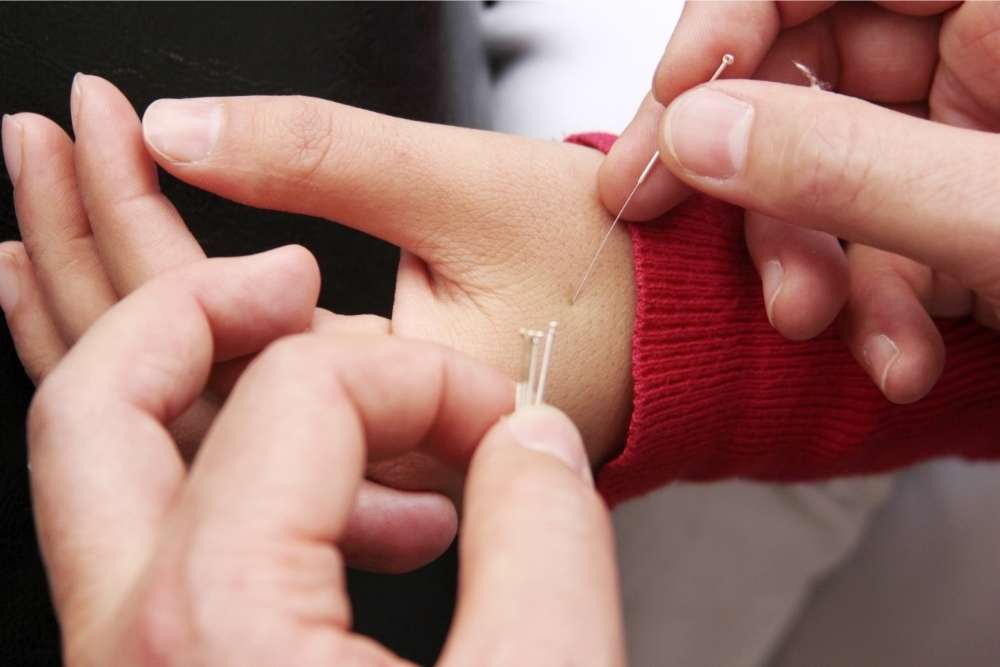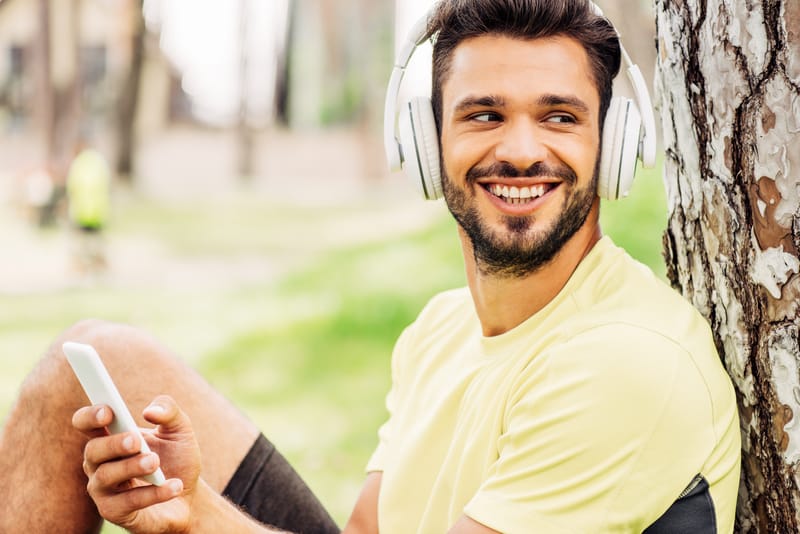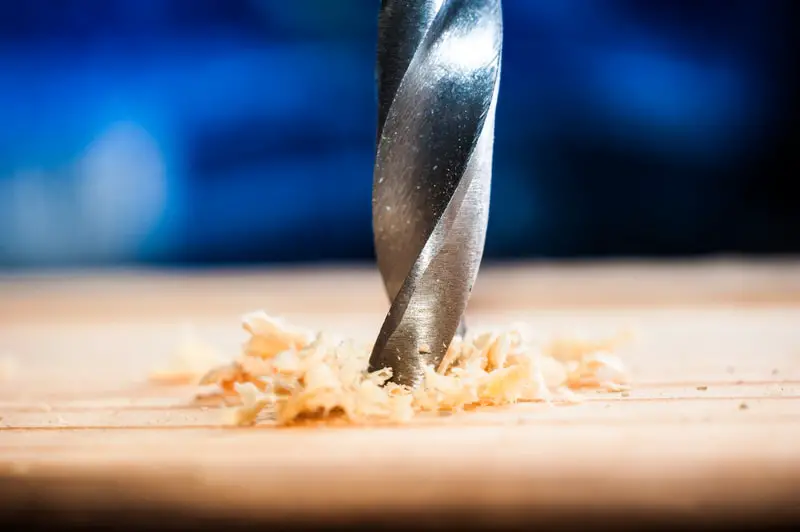Extensive research has been conducted into the effects of acupuncture on muscle cramps, tension, and spasms. These studies have proven the efficacy of acupuncture in breaking the pain-spasm-pain cycle. They can reduce the pain associated with these issues by relaxing the muscles and increasing the threshold of the pain receptors in your body.
What Is Acupuncture?
Acupuncture is a staple practice in traditional Chinese medicine. It involves inserting fine and sterile needles into specific locations on the body known as meridian lines.
These are the areas the qi (vital life force) is believed to flow through. The insertion of the needles is said to stimulate the flow of qi and rid your body of blockages or stagnation, believed to cause disease and illness.
Modern science’s interpretation of the efficacy of acupuncture is that the trigger points are full of nerve endings. When the needles are inserted then this stimulates the nerves and has a positive effect on the rest of your body.
Trigger Point Acupuncture Therapy
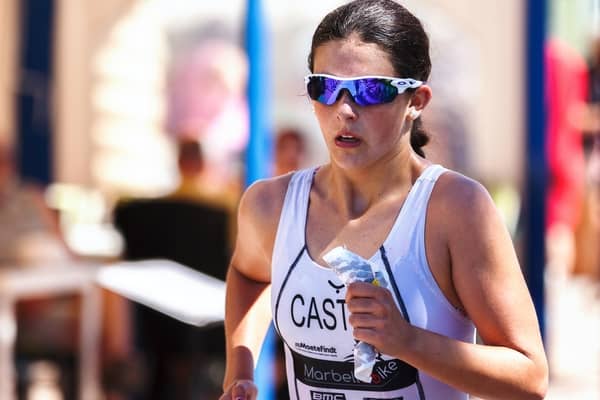
A trigger point is a painful area on your body, specifically in the skeletal muscles, that is linked to a very sensitive node in the muscular banding. When pressed it is really painful and can have negative impacts on the muscles around the body.
These trigger points will often feel like tight knots in the muscle tissue and will be painful when pressed. These trigger points are also likely to inhibit your muscle’s range of motion.
Acupuncture can be used to release trigger points by forcing the muscles to contract involuntarily.
When a trigger point is released the muscle is allowed to relax and becomes elongated. After it has contracted and relaxed a few times, it will become softened and stay in a more naturally elongated state. This is sometimes described as a melting sensation.
The muscle tissue becomes healthier as a result of the relaxation. Your range of motion will increase, and the pain that you feel will be greatly reduced.
The acupuncture also helps to promote blood circulation to the tissue in the localized region. This allows sufficient oxygen and nutrients to reach the muscle tissue, keeping them in optimal working condition.
This subtype of acupuncture is also sometimes referred to as dry needling. This uses similar methods to acupuncture, however, acupuncturists must undergo a long period of rigorous training.
Dry needling does not require the same education and is often performed by physical therapists. Some people prefer using this term as they do not believe in the idea of qi associated with the Chinese practice of acupuncture. Others will simply use it as a way to protect themselves while performing women’s acupuncture.
Acupoint: Bl-57 (Other Names: Urinary Bladder-57/Cheng Shan/Support the Mountain)

This acupuncture point is known as Bl 57, Urinary Bladder 57, Mountain Support, and Cheng Shan. To find it you will need to feel down the back of your calf, approximately halfway between the knee crease and the ankle. Feel in the center of your calf for a small dip between the muscles.
If you struggle to find it, press the ball of your foot against something to increase the resistance. Press along this point firmly for between 2 and 3 minutes.
This pressure point has a number of beneficial effects on the body. It can be used to relieve hemorrhoids, heel, and foot pain. This pain can be caused by paralysis, trauma, or neurological disorders. It is also a key point for pain, cramping, and swelling of the calf muscles.
Acupoint: GV-26 (Other Names: The Governing Vessel-26/Ren Zhong/Middle of the Person)

This acupuncture point is known as Governing Vessel 26, Water Trough, Shui Gou, or the philtrum. To find it, you should feel for the dip just underneath your nose, in the center of your face. The center of this dip is GV 26.
This pressure point is the main one for treating shock, returning people to consciousness, weakness, and waking up sleeping patients. It is also commonly used to alleviate acute sprains in the lower lumbar region – reducing pain and allowing for a wider range of motion.
It is believed to send any stagnant energy to the opposite end of the channel, so it is vital that you bend and rotate the wrists following activation of this point. It can also help with nasal problems, smelling, manic depression, and epilepsy.
Acupoint: Liv-3 (Other Names: Liver-3/Tai Chong/Supreme Rush)

This acupuncture point is known as Liver 3, Great Surge, or Tai Chong. To find it you will need to look at your foot. Look for the area of webbed skin where your big toe connects to the next one. Apply firm and deep pressure to this region for around 3 minutes to feel the effects.
This point has a huge number of beneficial effects on the body when activated. It can remove stagnation throughout the body, and balances everything associated with the liver meridian.
This includes headaches, canker sores, dizziness, eye pain, and blurry vision. It is also useful to resolve issues with menstruation, PMS, breast tenderness, and general problems associated with the genital region.
This point also has strong links to the chest and abdominal regions. It is particularly useful to help with digestive problems like constipation, vomiting, nausea, and diarrhea.
It has been said to calm anger and irritability while alleviating insomnia and anxiety too.
Acupoint: Ren-4 (Other Names: The Conception Vessel-4/Guan Yuan/Origin Pass)
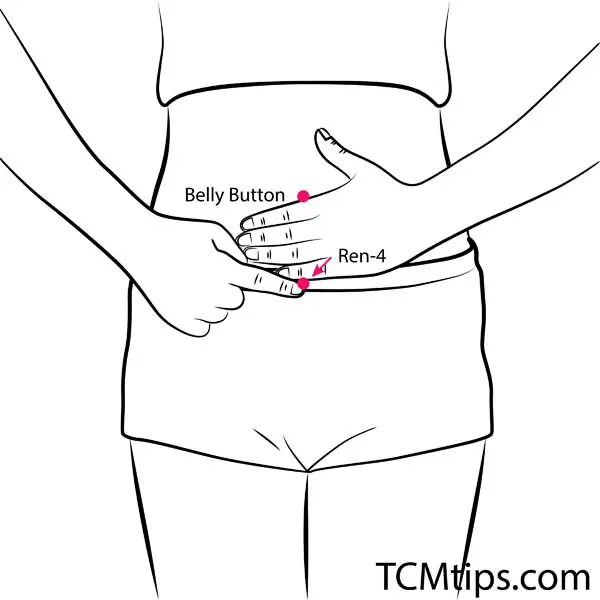
This acupuncture point is known as Conception Vessel 4, Origin Pass, and Guan Yuan.
It is a good acupuncture point for Yin, Yang, Qi, and blood deficiencies. It can be used to counteract weakness, chronic fatigue, chronic diseases, and exhaustion – especially in prenatal women. It is also very good for treating lower back pain, bone problems, rectal prolapse, and diarrhea.
It can also help with bedwetting and incontinence. This is good for menstrual issues, impotence, and bleeding during pregnancy. It can also reduce chills, the sweats, and unconsciousness. It can also be used to treat general weakness, sexual problems, and shortness of breath.
Acupoint: Ren-6 (Other Names: The Conception Vessel-6/Qi Hai/Sea of Qi)
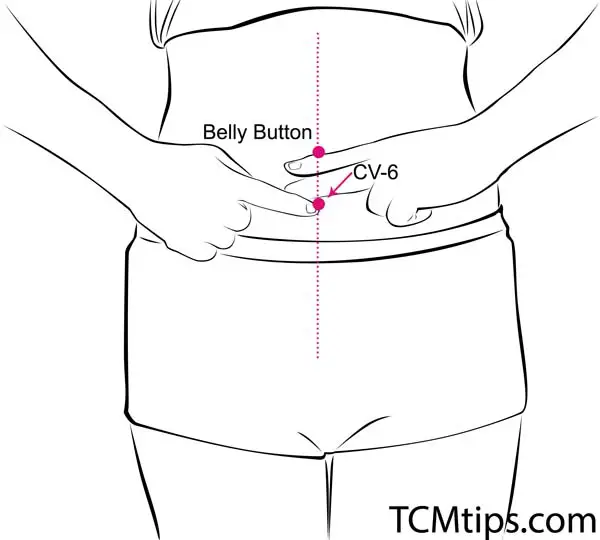
This acupuncture point is known as Conception Vessel 6, Sea of Qi, and Qi Hai. This acupuncture point is found directly down the center of the body. It is located 3 inches or 4 finger-widths below your navel.
You should apply firm pressure to this point using your fingers, knuckles, or palms. This pressure should last between 1 and 2 minutes.
This point is very effective at helping improve womens’ health, particularly concerning issues such as bleeding, irregular periods, hernias, and amenorrhea. For men, this point can help with impotence, hernias, ejaculation, and bedwetting.
If you suffer from a distended stomach, bloating, digestive issues, diarrhea, or fatigue this is a very important acupuncture point. It is also good for prolapses and gential swelling. CV6 can also be activated to aid recovery from fainting, strokes, and overall bodily weakness. It is also great for shortness of breath, asthma, and general fatigue.
Acupoint: KI-1 (Other Names: Kidney-1/Yong Quan/Gushing Spring)
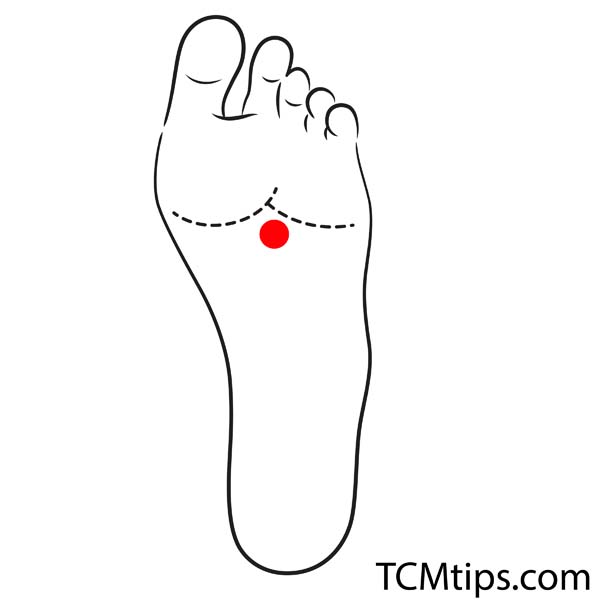
This acupuncture point is known as KI 1, Gushing Spring, and Yongquan. This point is found on the sole of the foot, about ⅓ of the way down from where your toes begin.
To find it more easily, look at the sole of your foot as you curl your toes. You will notice a small depression on the horizontal midline of your foot – this is K 1.
This point can be used to treat hypertension, epilepsy, tinnitus, and headaches. It is a cooling point, and as such, can alleviate throat pain, lower back pain, and dry mouth.
It is also great for helping to reduce insomnia, anxiety, heart palpitations, hot flashes, and night sweats.
This point is believed to have good impacts on mental health too. It is believed to reduce mania, particularly rage with homicidal tendencies.
It can also help with recovery following periods of unconsciousness. K1 can also help reduce headaches and nausea.
Acupoint: LU-7 (Other Names: Lung-7/Lie Que/Broken Sequence)

This acupuncture point is known as Lung 7, Broken Sequence, and Lie Que. To find this point, you will need to look at the inside of your arm.
Interlock your thumb and index fingers on both hands. Look for a dip in between the sinew and the bone at the end of the index finger – this is the acupuncture point.
The purpose of activating this point can have external and internal wind uses. Externally, it can help to alleviate chills and fevers, aches across the body, sneezes, runny noses, and itchy throats. Internally, it is believed to help with Bell’s palsy, spasms, lockjaw, and muscular twitches.
It is also known as the Master point of the Conception Vessel and can help to treat gynecological and genitourinary problems. It is also the Command point of the head and back of the neck, so can alleviate pain localized to these regions.
Acupoint: LU-9 (Other Names: Lung-9/Tai Yuan/Supreme Abyss)
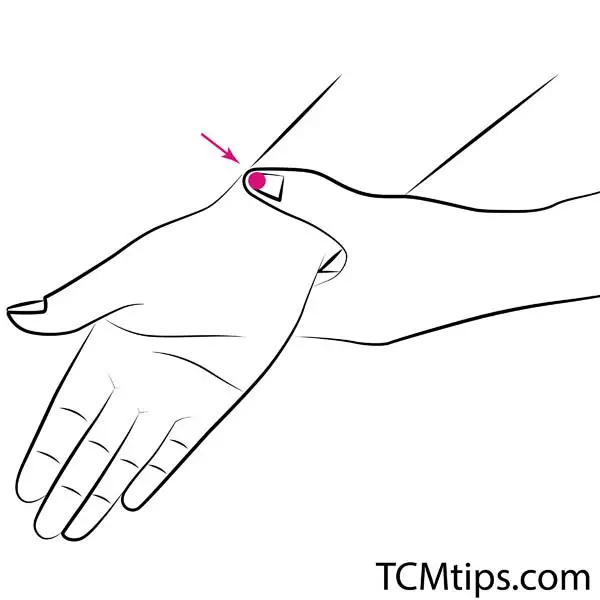
This acupuncture point is known as Lung 9, Great Abyss, and Tai Yuan. It is located on the crease of your wrist, just underneath the thumb, in the dip.
It can be used to treat coughs, asthma, wheezing, and chronic runny noses. It can alleviate heart palpitations, wrist, and arm pain. It can also help improve circulation and help to strengthen a weak pulse.

Try our Anti-Aging Gua Sha Tool designed to bring out your skin’s natural glow.
Best Gua Sha Product- Anti-Aging: The tool is designed to target 11 specific aging signs such as wrinkles and sagging skin. By following the 7-step routine, users can improve skin firmness and reduce fine lines naturally.
- Enhances Skincare Routine: It works effectively with serums and lotions, boosting absorption and efficacy of skincare products.
- Visible Skin Improvement: Users can expect a smoother complexion, reduced puffiness, and a more youthful appearance.
 P. Sze
P. Sze 